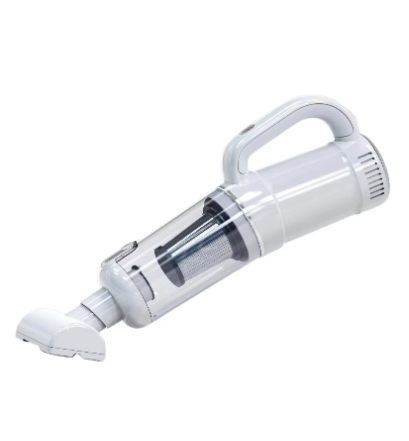Understanding the Modern Solution for Vehicle Interior Cleaning
Keeping your vehicle's interior pristine has never been more convenient thanks to car auto vacuum cleaners. These powerful yet compact devices have revolutionized how we maintain our vehicles' cleanliness, offering a practical solution for dealing with everyday messes, from cookie crumbs to pet hair. As vehicles become an extension of our living spaces, maintaining their cleanliness has become increasingly important for both comfort and value preservation.
Car auto vacuum cleaners are specialized cleaning devices designed specifically for automotive use. Unlike traditional household vacuum cleaners, these units are engineered to handle the unique challenges of vehicle interior cleaning, combining powerful suction with portable design and specialized attachments. They've become an essential tool for car owners who value cleanliness and want to maintain their vehicle's interior condition without frequent trips to professional detailers.
Essential Components and Technology
Power Systems and Suction Mechanisms
The heart of any car auto vacuum cleaner is its motor and suction system. Modern units typically feature high-efficiency motors that can generate significant suction power while running on 12V DC power from your vehicle's cigarette lighter port or rechargeable batteries. The suction mechanism is carefully calibrated to handle various types of debris commonly found in vehicles, from fine dust to larger particles.
Advanced models incorporate multiple-stage filtration systems, ensuring that captured dirt and debris remain trapped within the unit. This technology not only improves cleaning effectiveness but also prevents dust from being released back into the vehicle's atmosphere during operation.
Filtration and Collection Systems
The filtration system in a car auto vacuum cleaner typically consists of multiple layers, each designed to capture different sizes of particles. HEPA filters are common in premium models, capable of trapping microscopic particles and allergens. The dust collection chamber is engineered for easy emptying and maintenance, with many models featuring transparent containers that allow users to monitor debris levels.
Modern filtration systems also incorporate washable components, reducing long-term maintenance costs and environmental impact. This sustainable approach to filter design ensures optimal performance while minimizing the need for replacement parts.
Design Features and Ergonomics
Portable and Compact Construction
A car auto vacuum cleaner's design prioritizes portability without compromising cleaning power. Manufacturers carefully balance weight distribution and ergonomic grip designs to ensure comfortable operation in confined vehicle spaces. The compact construction allows for easy storage in car trunks or under seats, making it readily available whenever needed.
Most units feature lightweight materials such as durable plastics and aluminum components, reducing operator fatigue during extended cleaning sessions. The thoughtful design extends to cord management systems and attachment storage solutions, ensuring all components remain organized and accessible.
Specialized Attachments and Accessories
Every car auto vacuum cleaner comes equipped with an array of specialized attachments designed to tackle specific cleaning challenges. Crevice tools allow for effective cleaning between seats and along trim lines, while brush attachments help agitate and remove stubborn dirt from carpets and upholstery. Extension tubes provide additional reach for cleaning under seats and in trunk spaces.
Premium models often include LED lighting systems integrated into the nozzle, illuminating dark areas under seats and in corners. This feature ensures thorough cleaning even in poorly lit conditions, helping users maintain a consistently clean vehicle interior.
Performance and Practical Applications
Cleaning Efficiency and Coverage
The effectiveness of a car auto vacuum cleaner is measured by its ability to handle various cleaning scenarios. These devices excel at removing both surface debris and deeply embedded dirt from vehicle carpets and upholstery. The combination of powerful suction and specialized attachments ensures comprehensive cleaning coverage, reaching areas that traditional vacuum cleaners might miss.
Modern units are designed to maintain consistent suction power throughout the cleaning session, even as the collection chamber fills. This sustained performance is crucial for achieving thorough cleaning results, particularly in larger vehicles or when dealing with substantial debris accumulation.
Time-Saving and Convenience Features
One of the primary advantages of using a car auto vacuum cleaner is the significant time savings compared to traditional cleaning methods. Quick setup and operation allow for efficient spot cleaning or complete interior maintenance. The ability to plug directly into a vehicle's power source or operate on long-lasting batteries eliminates the need for external power sources.
Advanced models incorporate features like automatic cord rewinding, quick-empty dust bins, and tool-free maintenance capabilities. These convenience features streamline the cleaning process, making regular vehicle maintenance more accessible and less time-consuming.
Maintenance and Care Guidelines
Regular Cleaning and Filter Maintenance
Maintaining optimal performance of your car auto vacuum cleaner requires regular attention to its components. Filter cleaning or replacement should be performed according to manufacturer recommendations, typically every few months depending on usage frequency. Regular emptying of the dust collection chamber prevents suction loss and ensures consistent cleaning performance.
Users should inspect attachments for wear and damage, cleaning them thoroughly after each use to prevent debris buildup. Proper maintenance not only extends the device's lifespan but also ensures reliable operation when needed.
Storage and Protection Practices
Proper storage is crucial for maintaining your car auto vacuum cleaner's condition and performance. The unit should be stored in a clean, dry environment, protected from extreme temperatures and direct sunlight. Many models come with storage bags or cases that protect the device and keep accessories organized.
Regular checks of power cords and connection points help identify potential issues before they affect performance. Following proper storage and protection practices ensures your investment continues to provide reliable service for years to come.
Frequently Asked Questions
How often should I use my car auto vacuum cleaner?
For optimal vehicle maintenance, it's recommended to use your car auto vacuum cleaner at least once a week for regular cleaning, and immediately after any spills or obvious debris accumulation. This frequency helps prevent dirt from becoming embedded in carpets and upholstery.
Can car auto vacuum cleaners damage vehicle upholstery?
When used properly with appropriate attachments, car auto vacuum cleaners are safe for all types of vehicle upholstery. Always test new attachments on a small, inconspicuous area first, and avoid using excessive pressure when cleaning delicate surfaces.
What's the average lifespan of a car auto vacuum cleaner?
With proper maintenance and care, a quality car auto vacuum cleaner can last 3-5 years or more. Regular cleaning, filter maintenance, and proper storage significantly impact the device's longevity and performance over time.

